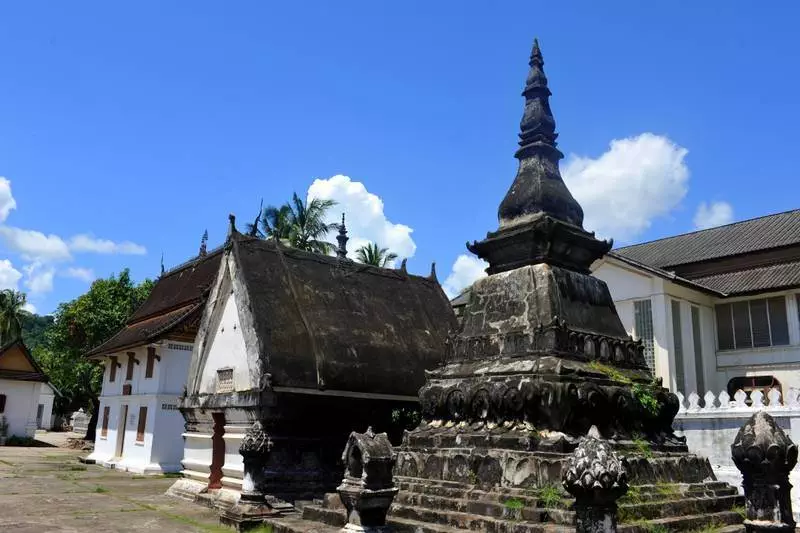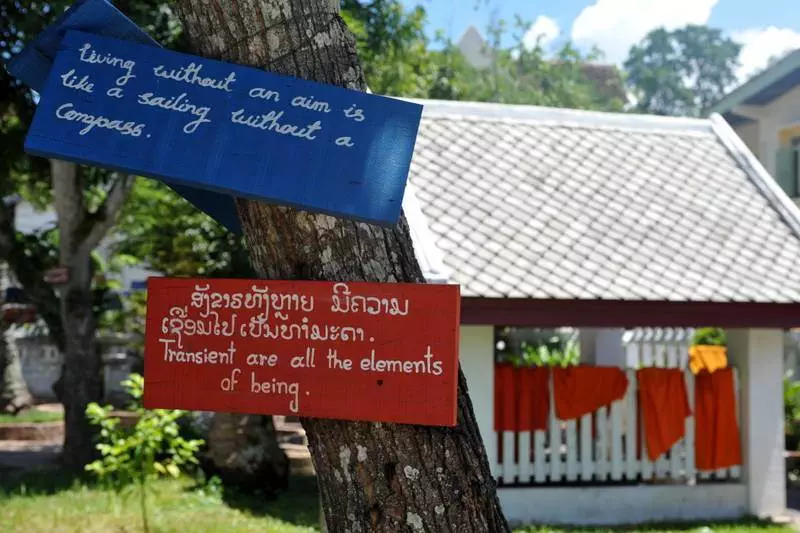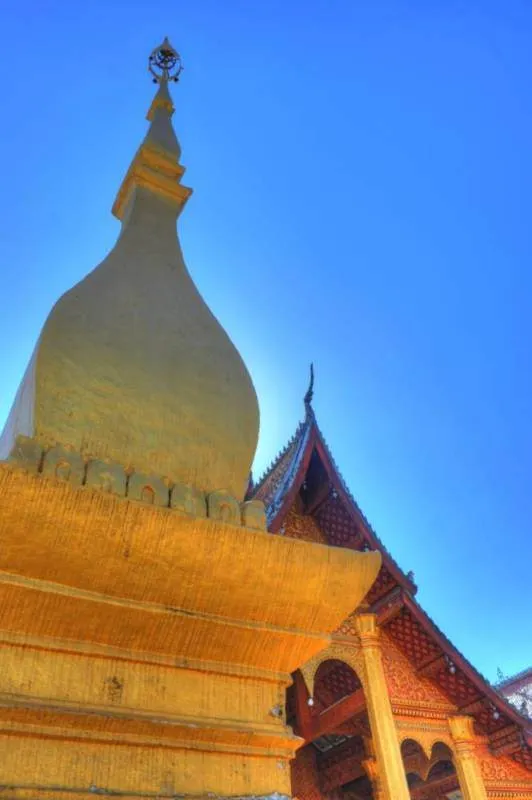With Vientiane explored, it was time to move on Laos’ second city, Luang Prabang. Added as a UNESCO World Heritage site in 1995 revitalized the area, which is now slowly gentrifying and plenty more touristy than ever before. This isn’t the sort of place I’d ordinarily visit, but there’s enough interesting stuff around that I enjoyed this city more than Vientiane.

Luang Prabang’s UNESCO heritage status comes from the “fusion of traditional architecture and Lao urban structures with those built by the European colonial authorities in the 19th and 20th centuries”. Today, the “urban structures” are still around, though far more of them are used in the tourist sector than as private homes.
Table of Contents
Wat Maysouvanhnaphoumaram

It won’t take you long to discover the many temples or the French colonial architecture. Above is Wat Maysouvanhnaphoumaram — (also spelled Wat Mai Suwannaphumaham, or Wat Mai — 10,000 kip admission) — one of the smaller temples with some English-language Buddhist sayings on wood signs. Originally built in 1796 and rebuilt in 1821, it was spared by the Haw invasion forces because it was too beautiful to damage. Check out the longboats — although 20–25 meters long, I doubt they’ll sail again.

Love the black-and-gold pattern You could spend a full day walking around the city’s major and minor temples — there are that many of them.
Next up: the Luang Prabang National Museum…

Yet another temple by the museum’s entrance — Ho Pha Bang — originally built to house the 83cm-tall gold-alloy 14th-century Buddha image called Pha Bang. While still on display along the palace’s southern terrace, it’s not exactly the star attraction, so look carefully for it. This museum is also the place to see the Royal Ballet Theatre (100,000–150,000 kip) in the evening.

This is not the country’s most tourist-friendly area. No pictures were allowed inside, some restrictive hours are in place (8am-11:30am and 1:30pm-4pm, last admission at 3:30pm, and closed on Tuesdays), and modest dress expected (“midriff, upper arms and upper legs covered”). Don’t forget to take off your shoes outside and leave your bags in the lockers provided. With that said, the museum offers a combination of mid-20th century European style fit for a king and classic art and architecture aplenty.
Also around are swords of the king’s bodyguards, stone tablets, some written in ancient Lao, one from the 7th century. A private reception room with gifts offered the king, including 1670’s cabinet from Gerrit Van Wuystof of the Dutch East India Company. Peek into the king’s bedroom for a larger-than-life portrait of himself, perhaps 2 meters wide by 3.5 meters tall. There’s the royal howdah used by the king for elephant riding, and scattered around the building is the legend of Prince Wetsantara, considered the reincarnation of Buddha.

Keep an eye out for two gold-colored carriages outside the royal museum One carries the Prabang Buddha — made in 2011, this carries the Buddha image that gets splashed with water during the Song Nam Pha ceremony (similar to Songkran in Thailand). The other, also made in 2011, carries a monk during the Lao New Year parade in mid-April.
Your 30,000 kip admission also pays for entry to the Royal Car Museum — open only from 8am-11:20am and 1:30pm-3:50pm, you have to time it almost perfectly to see the trio… A handful of vehicles are inside, including a 1972 Jeep, a 1950’s Edsel (for formal occasions), and a Citroen circa 1950 — the royal chauffeur preferred this car to the others because it had a stick shift.
The final stop inside is Hwa Prabang (Floating Buddha) — a photo exhibit by Hans Georg Berger. He used a medium format Hasselblad to capture the monks and novices as they were learning meditation — a sensitive time, to say the least, and one photographers don’t ordinarily get to capture. It’s a mostly black-and-white collection, meaning the color images pop out at you.
Overall, it’s a middling attraction at best — the opening hours seem a hold over from the French’s penchant for two-hour lunch breaks, while the no photo rule remains a bummer to folks that know how to turn off their flash.
Traditional arts, crafts, and clothes

More interesting and as accessible is TAEC — the Traditional Arts and Ethnology Centre — a fascinating look at the various tribal groups and diversity that make up Laos. From the very beginning, you’re reminded that the country, slightly smaller than the United Kingdom, has four major linguistic groups and over 100 groups or sub-groups. Each group has some clothes or other colorful stuff on display, from women’s headdresses to handmade beds and looms that can be strapped to one’s back.

The next room looks at cultural practices and beliefs — weddings, for example, are one life event that is well-documented here.

A Kmhmu Kouene ‘back strap loom’ — one end is anchored to a tree or house stilt, while the other end is strapped around the weaver’s back. The whole thing is mobile, and can be taken up quickly when needed.

A Yao Mun Celestial Crown, or what’s worn by the bride in Nam Lue village.
While these pieces aren’t for sale, the museum shop features plenty of colorful items made by the various tribes, with a significant portion of the proceeds going back to the workers. The coffeeshop also helps keep the place running, and it’s a peaceful place worth checking out.
Wat Sensoukaram

Also on one of the main streets is Wat Sensoukaram (free admission), dating back to 1718 and featuring some wonderful ruby walls. Much of it looks like Wat Maysouvanhnaphoumaram from earlier in this post, but it’s well worth seeing all the same. The same gold-and-black color scheme presides over much of the temple, and pairs very well with the vividly blue skies.

And then there’s the Mekong — head to the river road and cross via ferry to see a few temples, bikeable from the ferry landing on the other side. Stay on the more populous side to see plenty of restaurants along the river, and dozens of guesthouses just inland.
Wat Xieng Thong

If you thought you were done with the temples, there’s at least one more big one the first part didn’t mention: Wat Xieng Thong (20,000 kip admission, open 6am-6pm). This was the temple where kings were crowned, and a very rare reclining Buddha has remained safe in the Red Chapel (Haw Tai Pha Sai-nyaat).
Fully spelled out, it’s Wat Xiengthongratsavoravihanh. With assistance from the U.S. Embassy, the sim (main building) was renovated from January 2011 to May 2012, and an English sign describes the changes that were made. The temple’s buildings offer some colored glass and plenty of intricate details to take in:
Shiny. I do wish the temples — especially the ones that survived the massacre in 1887, like this one — had more information on site. The Wikipedia page or the Lonely Planet is fine reading, but I’d much rather hear it from the place itself.
Luang Prabang’s night market – a more lively stop

If you’re meandering around town, you’ll find it — it runs several hundred meters in the middle of the street. You’ll see the same things over and over again — t-shirts, aluminum souvenirs made from the metal in old bombs, pajama-looking pants, and lanterns in the shape of Angry Birds.
Prices are generally good to very good, but bring smaller bills and don’t hesitate to negotiate — someone just down the street is almost certainly selling the same thing(s) a bit further on. Some of the same offerings are also at the Vientiane night market along the river.
Local textiles, anyone?
One final stop worth making is at Ock Pop Tok (free admission):

Along Thanon Sisavangvong (the same road as the coffeeshops and travel agencies) is an excellent introduction to local crafts. These are ethically produced by over a dozen groups with the monies flowing back to the craft-makers.
Opened in 2000 by a local weaver and English photographer, the shop’s aim is to empower women through their traditional skills and show off Lao textiles. Pieces are a bit pricey, as well-made crafts usually are. Learn more at ockpoptok.com.

Wedding blankets, anyone? 100% silk blankets reproduce the style of the Tai Daeng, complete with motifs of nagas (symbolizing safe sleep) and pregnancy (you can guess why). Each one supposedly takes more than 2 months to make.
If you’re smitten by the idea of creating your own crafts or meeting the weavers, ask about the classes offered at the Living Crafts Centre. Opened in 2005, it offers a first-hand opportunity to see the weavers work. The Living Crafts Centre is open from 9am-5pm and is several kilometers west of the walkable center down Sisavangvong (which turns into Chao Fa Ngum and later Phothisarat), near the Phosy Market. They offer a free tuk-tuk shuttle between the stores and centre, which leaves the shop at 8:45am and returns at 4pm. Classes run ½ day to three full days in length. Call 071–212597 or lcc@ockpoptok.com for more information.
If you’re industrious, Luang Prabang’s walkable center can be seen in one long day or two rather lazy days. There are other sights nearby that are daytrippable, and will be featured in posts coming soon.
To be clear, you’re not breaking any new ground here. It’s entirely possible to stay in the touristy bubble and never see a more authentic side of Laos. It’s redemption comes from the somewhat exotic location, combined with the almost fanciful fussiness to Western details (how do you like your cappuccino and crepes?). It remains a cheap destination, even with a few indulgences — just remember to do the mental conversions when going from Lao kip, Thai baht, and US dollars.
If you’re an adventuresome sort, or if you really enjoy traveling the third-world way, by all means take the bus that leaves Vientiane for Luang Prabang. In theory, it’s a 12 hour bus ride, but in reality it can easily take almost double that — buses break down, roads become impassable for one reason or another, and drivers will naturally take the slow approach up a dark mountain road with no guardrails. The ‘VIP’ bus (typically a retired Korean or Chinese bus) seems a small step up from the ‘chicken bus’ you’ve probably heard stories about; while reasonably comfortable, it’s very slow. Do it if you want the experience, or head to any travel agent in town to book a flight to Luang Prabang — as of this post four flights a day make the 40 minute flight (8:55am, 11:45am, 3:30pm, and 4:30pm).
However you arrive, Luang Prabang is quite walkable or bikeable — no need to bother with the dozens of tuk-tuks unless you’re headed to the airport, bus terminal, or out of town.








